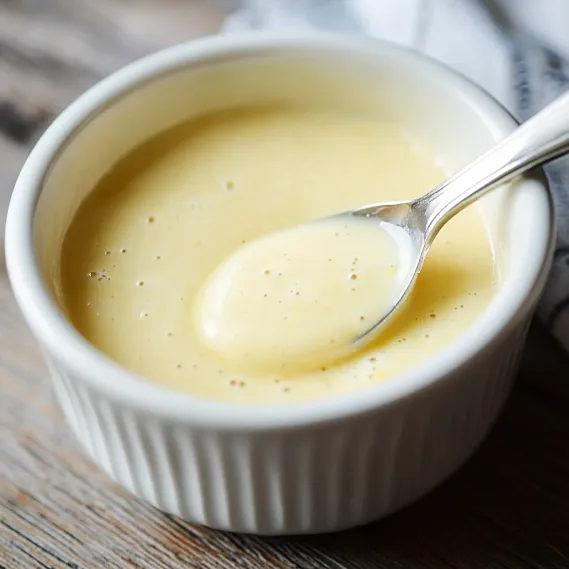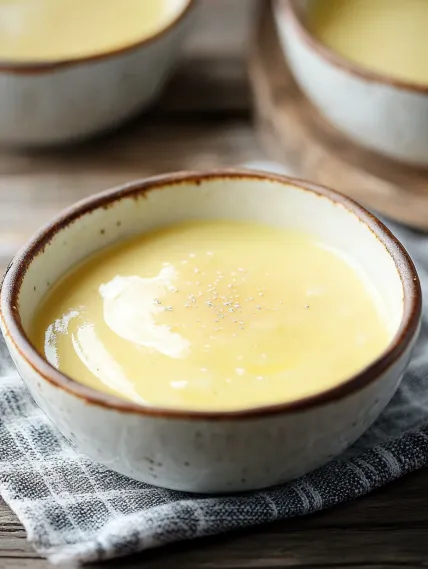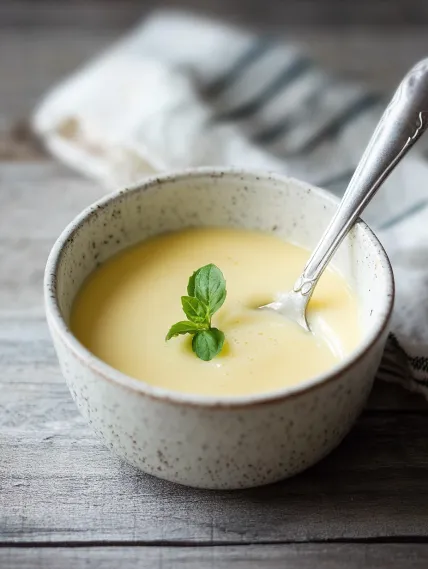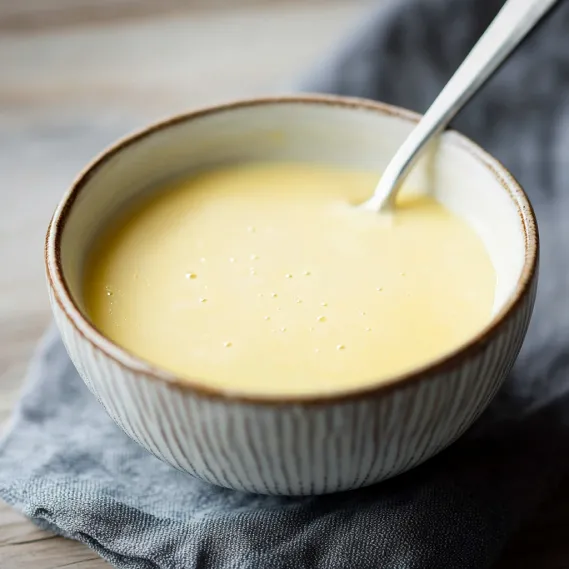 Pin it
Pin it
This silky, golden custard transforms ordinary desserts into elegant culinary experiences with its rich vanilla flavor and velvety texture. Unlike store-bought versions or shortcuts using cornstarch, this authentic Creme Anglaise relies solely on egg yolks for thickening, creating that distinctive luxurious mouthfeel that coats the back of a spoon perfectly.
I recently served this custard over a simple apple cake at a dinner party, and my guests were convinced I had spent hours in the kitchen. The reality? This luxurious sauce took just 20 minutes of mostly hands-off preparation. The difference between this homemade version and anything from a carton is truly remarkable – like comparing fresh cream to powdered milk.
Essential Ingredients and Selection Tips
- Vanilla Bean: The tiny black seeds provide intense, aromatic flavor. While expensive, one bean transforms the entire custard with unmatched complexity.
- Heavy Cream: Choose cream with at least 35% fat content for richness. Lower fat options work but need longer cooking to thicken properly.
- Egg Yolks: These provide both color and thickening power. The fresher your eggs, the more vibrant yellow your custard will be.
- Sugar: Superfine or caster sugar dissolves more quickly, but regular granulated works fine with enough whisking.
- Milk: A small amount balances the richness of the cream. Whole milk gives the best results, but reduced-fat will work too.
I've discovered through multiple tests that the quality of your vanilla makes the biggest impact on flavor. While vanilla extract works in a pinch, nothing compares to the complex flavor and visual appeal of real vanilla bean specks suspended throughout your custard.
Detailed Cooking Instructions
- Step 1: Prepare Your Vanilla Infusion
- Split a vanilla bean lengthwise with a sharp knife and scrape out the tiny black seeds. Add both the seeds and the pod to a saucepan with 1 cup heavy cream and 1/4 cup milk. Heat gently until small bubbles form around the edges, then remove from heat and allow the vanilla to infuse for 5 minutes.
- Step 2: Create the Egg Base
- While the cream mixture steeps, whisk 3 egg yolks with 1/4 cup sugar in a medium bowl for about 2 minutes until the mixture becomes pale and slightly thickened. This incorporates air and helps dissolve the sugar completely for a smooth custard texture.
- Step 3: Master the Tempering Technique
- Remove the vanilla pod from the cream mixture and slowly pour about half the warm liquid into the egg mixture while whisking constantly. This critical step gradually warms the eggs without scrambling them. Once combined, pour this mixture back into the saucepan with the remaining cream.
- Step 4: Achieve Perfect Thickness
- Return the saucepan to low heat and cook gently, whisking regularly at first and then constantly as it thickens. Be patient—this takes about 8 minutes. The custard is ready when it coats the back of a spoon and you can draw a clear line through it with your finger.
- Step 5: Finish with Finesse
- Remove from heat immediately once thickened to prevent overcooking. For extra silky results, strain through a fine-mesh sieve to remove any tiny lumps or remaining vanilla pod pieces. Serve warm or cool to room temperature, during which time it will thicken slightly more.
 Pin it
Pin it
I learned the importance of patience with this recipe after my first attempt ended with tiny cooked egg bits throughout my custard. Now I maintain a low heat and whisk constantly toward the end, resulting in perfectly smooth, lump-free custard every time.
The Secret to Perfect Texture
The magic of this custard lies in its contrasting textures - silky bottoms and tender, flavorful fillings. I've found that the key to achieving this is controlling moisture at every stage. First, properly squeezing the salted cabbage removes excess water that would otherwise make the filling soggy. Second, the cornstarch not only binds the filling but also absorbs any remaining moisture. Finally, the cooking technique - first frying, then steaming, then frying again - creates that signature crispy bottom while ensuring the filling cooks through perfectly.
 Pin it
Pin it
Make-Ahead Magic for Entertaining
One of the greatest advantages of this recipe is its make-ahead flexibility. I often prepare this dish on a Sunday afternoon, letting it simmer for hours while I tend to other chores. Once cooked, it freezes beautifully for up to three months. Simply reheat gently on the stovetop, adding a splash of water if needed to loosen the sauce. This prep-ahead magic means I can serve impressive homemade dinners even on the busiest weeknights.
Transforming Leftovers Into New Meals
If you somehow end up with leftover custard (though this rarely happens in my house!), it can be transformed into entirely new dishes. Shredded custard makes an excellent filling for empanadas, burritos, or even savory crepes. My favorite repurposing trick is to nestle halved custard atop a bowl of creamy grits, creating a satisfying breakfast that carries the flavors into the next day.
 Pin it
Pin it
Chef's Helpful Tips
- Allow the custard to rest for 5 minutes after baking before serving – this helps set the interior for the perfect bite
- For extra flavor dimension, add a teaspoon of smoked paprika to your panko mixture
- If you have trouble finding custard locally, order it online from authentic suppliers like Bourgeois Meat Market or The Best Stop
- Serve with multiple dipping options – a spicy remoulade and cool ranch alongside the Louisiana dipping sauce
- For a festive presentation, arrange the custard on a platter with alternating sprinkles of chopped parsley, purple cabbage, and yellow bell pepper to represent the traditional green, purple, and gold
Frequently Asked Questions
- → How do I know when my custard is cooked properly?
- The custard is ready when it coats the back of a wooden spoon, and you can draw a line through it with your finger that doesn't immediately fill in. This is called the 'nappe' stage. Be careful not to overheat it, as the eggs will scramble and the custard will curdle.
- → My custard curdled - what happened?
- Custard curdles when it gets too hot, causing the proteins in the eggs to tighten and separate. To prevent this, cook over low heat and whisk constantly. If it does curdle, you can sometimes save it by immediately removing from heat and blending until smooth, or straining through a fine sieve.
- → Can I use vanilla extract instead of a vanilla bean?
- Yes, you can substitute with 1 teaspoon of high-quality vanilla extract or vanilla bean paste. Add it after cooking, just before straining. However, real vanilla bean does provide the best flavor and those beautiful specks throughout the custard.
- → Why is my custard too thin?
- If your custard is too thin, it likely wasn't cooked long enough. The custard will thicken somewhat as it cools, but if it's still too thin, unfortunately you can't simply reheat and cook longer as it may curdle. Next time, cook it slightly longer until it properly coats the back of a spoon.
- → What can I do with leftover egg whites?
- Leftover egg whites can be used to make meringues, pavlova, angel food cake, marshmallows, macarons, or cocktails like whiskey sours. You can also freeze egg whites in an ice cube tray, then transfer to a freezer bag for future use.
- → How can I flavor this custard differently?
- Beyond vanilla, you can infuse the milk/cream with various flavors: Add citrus zest, cinnamon sticks, cardamom pods, coffee beans, or fresh herbs like mint or lavender during the heating stage, then strain out before proceeding. For chocolate custard, add 2-3 ounces of chopped dark chocolate to the hot custard and stir until melted.
